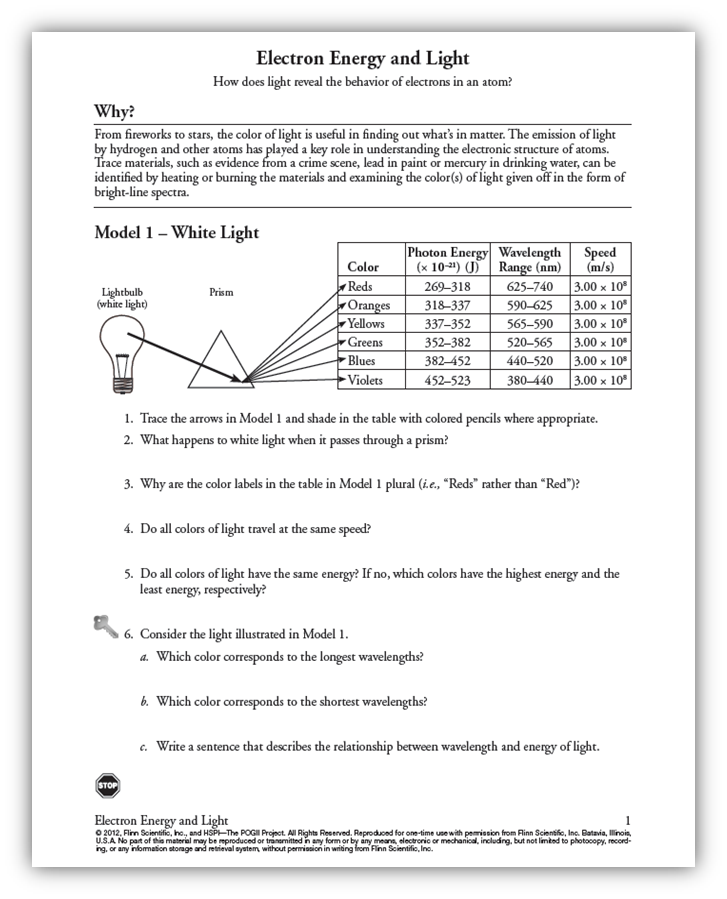Cracking The Periodic Table Code Answer Sheet TABLE OF CONTENTTABLE. Mission Statement and Project Overview. Historical Perspective on Information Systems. This WebElements periodic table page contains the essentials for the element lithium. Cracking the Code of the. Periodic Table of the Elements Specific Heat Capacity. Free PDF ebooks (user's guide, manuals, sheets) about Cracking the periodic table code answer ready for download.

POGIL Activity: Cracking the Periodic Table Code Summary Note to Students: The following paragraphs are meant to summarize the activity you did in class. Compare this summary to the one your teacher asked you to write. For homework use your comparison to write down all changes you would need to make to your summary to make it accurate and complete. If you notice something that this summary leaves out then please bring it to the attention of your teacher.
Your changes list should be typed and handed in to earn credit for this assignment. In this activity we practiced writing the ground state electron configuration for elements in the same column, or group, in the periodic table. Within a group we found that the electron configurations always ended with the same type of orbital with the same number of electrons. For example, in group 1 (the alkali metals) the electron configurations are: Li 1s 2 2s 1 Na 1s 2 2s 2 2p 6 3s 1 K 1s 2 2s 2 2p 6 3s 2 3p 6 4s 1 Rb 1s 2 2s 2 2p 6 3s 2 3p 6 4s 2 3d 10 4p 6 5s 1 Cs 1s 2 2s 2 2p 6 3s 2 3p 6 4s 2 3d 10 4p 6 5s 2 4d 10 5p 6 6s 1 Each of these elements has an electron configuration that ends with an s-orbital containing one electron: 2s 1, 3s 1, 4s 1, etc. Bmw E36 Fehlerspeicher Auslesen Software Downloads.
A similar result is found for the alkaline earth metals in group 2 (Be, Mg, Ca, etc.) Each of those elements has an electron configuration ending in s 2. For this reason, the first two columns in the periodic table are called the s-block. For all the elements in groups 3 through 12 the electron configurations end with a d-orbital. These groups make up the d-block of the periodic table.
The elements in groups 13 through 18 have electron configurations that end with a p-orbital so those elements are referred to as the p-block. Finally, the elements in the section usually printed below the rest of the table make up what is called the f-block. This is because they all have electron configurations ending with an f-orbital. The s-block is two columns wide because s-orbitals make up a sub-shell with only one orbital, which holds two electrons. Since only two electrons fit, the s-block is two columns wide.
The d-block is ten columns wide because a set of five d-orbitals holds up to ten electrons. The p-block is six columns wide because a set of three p-orbitals holds up to six electrons. The f-block is 14 elements wide because f-orbitals come in a set of seven. The final orbital of the electron configuration will always have the same number of electrons as the element’s distance from the beginning of the block it is in.
For example, nickel (Ni) is the 8 th element over from the beginning of the d-block and it has 8 electrons in the outermost 3d orbital. Also, bromine (Br) is the 5 th element over in the p-block so it has 5 electrons in a 4p orbital. Within the s-block the outermost orbital will have the same number as the period number, found at the left-hand edge of the periodic table. For example, the electron configuration of potassium (K) ends in 4s 1 because it is in the fourth row, or period. The same holds true for p-block elements: bromine’s electron configuration ends in 4p 5 because it is in the fourth period. For d-block elements the rule is a bit different. The last orbital in the electron configuration of a d-block element is always one less than the period number.
For example, nickel (Ni) is in the fourth row and has an electron configuration ending in 3d 8 and three is one less than four. Similarly, silver (Ag) has a predicted electron configuration ending in 4d 9 and four is one less than five. The first row of the periodic table only has two elements because the first shell only holds a single orbital which can hold just two electrons.
The second row has no d-block elements because d-orbitals only occur in energy levels 3 or higher. The d-block only begins in the fourth row of the periodic table because the 4s orbital is lower in energy than the 3d orbitals and fills first.
It is possible to figure out the electron configuration of any element using just the periodic table and knowing the types of orbitals and how many electrons they hold. The first row has elements up to 1s 2. The second row fills up 2s and 2p orbitals. The third row fills up 3s and 3p orbitals. The fourth row fills up 4s, then 3d, then 4p orbitals.